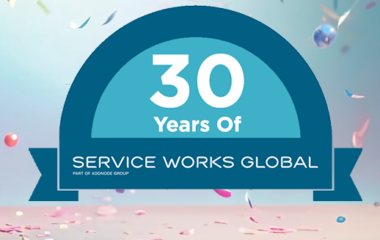This article by Service Works Global CEO, Gary Watkins, is also featured on i-fm.net.
Selecting and Implementing Tech in FM
FM software solutions offer wide-ranging benefits for workplace and facilities management professionals. But, choosing the ideal solution for your business’s unique requirements is vital.
Many factors must be considered before deciding to implement new FM software. Facilities management has grown in importance following the pandemic, and as more senior executives take an interest in building performance and management, FMs need to be ahead of the game.
FM software applications assist with management and planning in many areas, including:
- FM services – helpdesk, reactive maintenance reporting, budgeting and resource management
- Asset management
- Compliance, including health, safety, cleanliness and other regulatory control
- Management of SLAs and/or KPIs
- Service management
- Resource and workplace management – space management including hot desks, room, visitor and car park bookings and agile working
- Sustainability – environmental management and control including net zero targets
- Stock management, including spare parts inventory management and purchasing control.
There are also many motives for the deployment of FM software, typically:
- Cost saving
- Increasing financial control
- Improving efficiency by saving time
- Enhanced service
- Managing environmental strategies
- Qualified decision-making with accurate supporting information
- Management and improvement of health, safety and compliance.
Deciding between the numerous solutions available on the market can be a challenge and will depend on what your priorities are.
Factors to Consider When Looking for a Tech Solution
Different software has different strengths. Some may be laser-focused on one particular area, while others offer a host of features. It’s important to consider what your business needs are and base your decision around that. Here are some of the top areas where software can help –
Hybrid working: Following on from government-mandated remote working, many businesses continue to offer employees a more flexible work environment. Offices are becoming fluid spaces that need to meet the needs of more demanding occupants, supporting workplace collaboration while ensuring the health and wellbeing of employees. As such, demand for software that can manage hot desk and room booking systems has increased since the pandemic.
BIM and digital twins: Building information modelling has become more accessible to FM. For buildings where BIM was previously unavailable, technology can provide digitisation of spaces, from a digital floorplan to accurate 3D modelling. BIM data and FM software can be integrated to provide up-to-date and accurate building data to support effective maintenance regimes. A digital twin can be created by the input of sensor data, which will allow for digital scenarios to be modelled and considered before implementation physically.
Sensors and wellbeing: Building sensors can be used to monitor many factors within a building such as temperature, humidity and CO2 levels, and this data can be used to maintain a safe working environment.
Security: As businesses increasingly digitise, the risk of cyber-attacks increases. With remote/hybrid working a factor, many companies across all sectors are implementing IT monitoring services and two-factor identification on internal systems, including their FM software, to provide additional security.
Energy management: In a recent survey by Service Works Global, energy management was identified as the key challenge for FM professionals – overtaking budgetary pressures. Building sensors can feed into FM software to provide businesses with information that allows informed decision-making when considering the emissions and the net zero target of the organisation.
VR & AR: Augmented reality has entered the FM sector and provides the opportunity to overlay virtual building manuals over the physical space or to identify interior pipework and wiring invisible to the naked eye. AR has empowered engineers and has the potential to provide more efficient solutions to building maintenance. Virtual reality offers a new remote insight into a building where stakeholders can do a ‘walk-round’ without the need for physical attendance.
Integration
With so much choice, it is worth considering the value of integration. Managing multiple platforms will not necessarily improve the efficiency of FM, therefore choosing solutions that can integrate with existing systems is critical. Seamless integration can ensure that stakeholders are provided with convenient and real-time access to essential data at all times.
Building a Business Case
With so much ingenuity and choice of software, it is easy to get distracted by the functionality and excited by the possibilities. Choosing the right solution must be based on the strategic requirements of the organisation, and therefore be able to provide a case where the implementation has the necessary impact while providing a solid ROI.
Key factors when considering the introduction of software solutions include:
- The quality and scope of existing FM data
- Communicating information to required stakeholders
- Maintaining compliance with key legislation
- Budget allocated to the project, both upfront costs and ongoing expenditure, such as software support and maintenance fees
- User adoption, including training and supporting users of the system, and the costs for delivering such training.
Variable factors, such as developing hybrid working systems and flexible workspaces, can impact decision-making and thus any strategic plan to alter workplace use in the future must be considered.
Engaging Senior Stakeholders
When considering investment of a new FM software system, a board will want to see a systematic review of the business to help them to understand the critical directives and how the software will provide more effective and efficient services and generate ROI. Considerations in building your case include investment vs cost savings, functionality, time and cost efficiencies that the software will deliver. It is important to assess savings that will be gained over several years, ideally at least a five-year period. An initial assessment of business-critical factors will provide stakeholders with a wider understanding – when often they are disengaged with FM services – to make informed decisions.
Software vs SaaS and Payment
It is becoming more common for organisations to choose cloud-based (SaaS) software, managed via the software vendor. In addition to flexibility and scalability, this can offer wider security benefits, while also providing back-up support for business-critical data. In addition, an SaaS solution can provide cost benefits, too, with many organisations preferring to spread the costs via a fixed monthly or annual fee, as opposed to significant upfront costs.
To make an educated choice, build a five-year plan for post-purchase and create a cost benefit analysis. Cutting corners before purchasing to save costs can have a longer term impact on the ROI. Important factors to consider in an analysis are software investment, infrastructure costs (hardware, software, IT infrastructure), employee costs (including training and implementation time) and consultancy. This data, alongside the savings impact on the business, will allow key stakeholders a stronger insight into the benefits of upgrading or implementing new systems.
To Summarise
To make informed decisions before implementing any new software requires research, planning, analysis and budgeting.
Finding the right solution for your FM services is only possible if you have a robust plan that is based solely on the critical needs of the business.
Build the case, engage with stakeholders, look for vendor case studies and examples of work with clients similar to your organisation to enhance the argument. Great examples of the integration of software solutions can help further inform your plans, so engage with peers, talk to vendors and educate yourself before you begin your software journey.
When your decision is made, and before making any purchase, make sure you have an approved implementation plan, agreed with all stakeholders, that divides responsibilities and resources and sets KPIs. Effective preparation at the outset will ensure that your organisation derives maximum benefit from its FM software investment.








